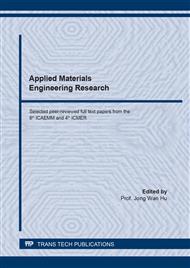p.77
p.83
p.89
p.95
p.105
p.111
p.119
p.125
p.133
Utilization of Talc as a Nucleating Agent in Poly(Lactic Acid) and Poly(Butylene Succinate) Blend
Abstract:
In this paper, poly(lactic acid) (PLA) was modified with poly(butylene succinate) (PBS) and talc to obtain PLA formulation with good toughness and high crystallization rate. PBS was added as a toughening agent at 40wt% and talc was added as a nucleating agent from 2 to 10wt%. Experimental results showed that both the tensile modulus and strength of PLA significantly decreased with the presence of PBS. Both values were found to notably increase with talc concentration and reached the maximum value at 8wt%. The tensile elongation at break was found to remarkably increase with PBS blending. However, it was linearly dropped with talc addition. Thermal test results also indicated the faster crystallization rate with the decreased crystallization temperature (Tc) and increased degree of crystallinity (Xc), by more than four times, when talc was added at least 4wt%. The isothermal crystallization half-time (t1/2) was applied to provide the data for injection molding process. The results showed that neat PLA required more than 25 min to obtain its half crystallinity. Minimum t1/2 of 3.45 min was obtained when talc was added to PLA/PBS at 8wt%. Heat distortion temperature (HDT) was also found to increase from 56.8 (neat PLA) to 97.2°C (8wt% talc). Based on the experimental results, the optimum talc concentration was 8wt% which provided the highest crystallization rate and thermal stability. The practical application of this formulation is for the biodegradable injection molding products.
Info:
Periodical:
Pages:
105-110
Citation:
Online since:
September 2021
Price:
Сopyright:
© 2021 Trans Tech Publications Ltd. All Rights Reserved
Share:
Citation:


